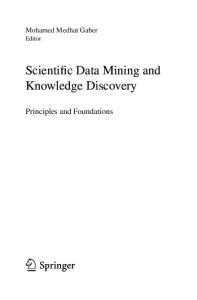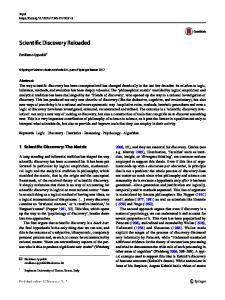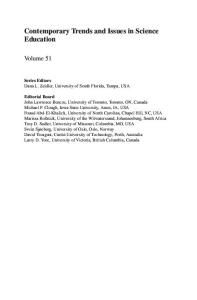Computational Discovery of Scientific Knowledge Introduction, Te
Advances in technology have enabled the collection of data from scientific observations, simulations, and experiments at an ever-increasing pace. For the scientist and engineer to benefit from these enhanced data collecting capabilities, it is becoming cl
- PDF / 7,106,328 Bytes
- 333 Pages / 430 x 660 pts Page_size
- 47 Downloads / 346 Views
Subseries of Lecture Notes in Computer Science
4660
Sašo Džeroski Ljupˇco Todorovski (Eds.)
Computational Discovery of Scientific Knowledge Introduction, Techniques, and Applications in Environmental and Life Sciences
13
Series Editors Jaime G. Carbonell, Carnegie Mellon University, Pittsburgh, PA, USA Jörg Siekmann, University of Saarland, Saarbrücken, Germany Volume Editors Sašo Džeroski Department of Knowledge Technologies Jožef Stefan Institute Ljubljana, Slovenia E-mail: [email protected] Ljupˇco Todorovski Department of Knowledge technologies Jožef Stefan Institute Jjubliana, Slovenia E-mail: [email protected]
Library of Congress Control Number: 2007931366
CR Subject Classification (1998): I.2, H.2.8, H.2-3, J.2-3, F.1 LNCS Sublibrary: SL 7 – Artificial Intelligence ISSN ISBN-10 ISBN-13
0302-9743 3-540-73919-X Springer Berlin Heidelberg New York 978-3-540-73919-7 Springer Berlin Heidelberg New York
This work is subject to copyright. All rights are reserved, whether the whole or part of the material is concerned, specifically the rights of translation, reprinting, re-use of illustrations, recitation, broadcasting, reproduction on microfilms or in any other way, and storage in data banks. Duplication of this publication or parts thereof is permitted only under the provisions of the German Copyright Law of September 9, 1965, in its current version, and permission for use must always be obtained from Springer. Violations are liable to prosecution under the German Copyright Law. Springer is a part of Springer Science+Business Media springer.com © Springer-Verlag Berlin Heidelberg 2007 Printed in Germany Typesetting: Camera-ready by author, data conversion by Scientific Publishing Services, Chennai, India Printed on acid-free paper SPIN: 12099696 06/3180 543210
Preface
Advances in technology have enabled the collection of data from scientific observations, simulations, and experiments at an ever-increasing pace. For the scientist and engineer to benefit from these enhanced data-collecting capabilities, it is becoming clear that semi-automated data analysis techniques must be applied to find the useful information in the data. Techniques from both data mining and computational discovery can be used to that end. Computational scientific discovery focuses on applying computational methods to automate scientific activities, such as finding laws from observational data. It has emerged from the view that science is a problem-solving activity and that problem solving can be cast as search through a space of possible solutions. Early research on computational discovery within the fields of artificial intelligence and cognitive science focused on reconstructing episodes from the history of science. This typically included identifying data and knowledge available at the time and implementing a computer program that models the scientific activities and processes that led to the scientist’s insight. Recent efforts in this area have focused on individual scientific activities (such as formulating quantitative laws) and h
Data Loading...











